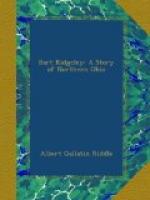He then proved that Cole left Massachusetts early in the spring of 1817, but failed to show when he reached Ohio, whether in 1817, or 1818. One man remembered to have seen Hiram Fowler at work for him on a tree fence, along the back line of it, during the summer of his arrival on the land. He also made proof, that at a very early day, tree fences were about at least three sides of the land, thus forming a cattle range, and evidencing possession and occupancy. He then called McConough, of Bainbridge, and men bent eagerly forward to gaze at the old Indian hunter, who had been a sharp-shooter on the ill-fated “Lawrence,” in Perry’s sea fight, off Put-in-Bay, and who was also with Gen. Harrison at the Thames; a quiet, compact, athletic, swarthy man, a little dull and taciturn. He said he was first on the ground in 1810 or 1811, and found a man by the name of Basil Windsor, who lived in a small cabin by the spring, near which he had then two small apple trees. He was there again, with John Harrington, in 1816. They drove a herd of elk through an opening, into and through Basil’s yard, at the south side, and back into the woods north, until they came to a tree fence, when they turned east, and were headed off by another hedge, and the elk were too tired to get over; and there in the angle they killed two or three, when it came on dark. That Harrington lit a fire, staid by the slaughtered elk through the night, to keep the wolves from devouring them, and that he, McConough, went and staid with Basil. That Basil was a sort of hermit, who lived in the woods and kept two or three cows. That on their way to Court a few days ago, he and Harrington went to the premises of Cole, and found his house near the old Basil spring, and that one of the apple trees was still standing there. The other had been recently cut down.
Harrington, a still more celebrated hunter and pioneer, and who furnished a good idea of old Leatherstocking, and who was with Winchester at the battle of River Raisin, from which he escaped, and was one of Harrison’s scouts, had been often at Basil Windsor’s. Hunters often found shelter there. He was there both before and after the war; and he fully corroborated McConough.
Old Bullock was then called, a heavy-framed, sluggish giant, of that strong, old-fashioned type of head and face, now nearly out of date. He, too, had served in the army, and was a famous hunter and trapper.
He knew Basil, a man who avoided others, and who had met with misfortunes “down country.” “He had hunted and trapped all through the woods about him, and knew of his having had fences to confine his cows. Knew Cole; he came in in 1817, 18 or 19, couldn’t tell which. Cole showed him his deed; went with him to find his land, and found it was the same on which Basil was living. Went with him to see Basil, who thought it was hard. He said that the land was his’n. He had a hundred and sixty acres; showed no deed or writin’s.




